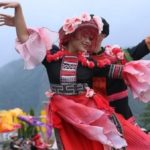The late author Vu Bang praised bun oc, or snail vermicelli soup, as a pinnacle of Hanoi’s fine dining in his book “Mieng Ngon Ha Noi” or Delicacies of Hanoi.

Hanoi’s autumn weather provides an ideal opportunity to enjoy bun oc for its crispness. The saying “The snail in October” suggests that the best time to eat this dish is when the snails are fat and in season.
When prepared by talented Hanoi chefs, bun oc becomes a delicacy. This popular dish made from hard-shelled mollusks living in muddy environments like ponds or rice fields is transformed into tasty dishes.
While the hot version of bun oc is more common, the cold version known as Bun oc nguoi is highly regarded by gourmets for its preservation of Hanoi’s raw and essential cuisine.
For over 30 years, Nguyen Thi Bau and her younger sister have been running a cold snail vermicelli soup shop on Tay Son Street in Dong Da District. They represent the third generation in their family to sell this dish.
Every morning, Bau carefully selects snails from the market, opting for those that are fresh and not slimy or fishy. She then soaks and washes them at home.

The snails are boiled for about 15 minutes, enough to keep the flesh fresh and to infuse the boiling water with the snail’s flavor, which is then used to cook the broth.
Bau shared her process, revealing that she only removes the snail meat from the shell when the customers arrive. This prevents the snails from dehydrating and becoming dry. She also removes any snail eggs to avoid an unpleasant crunch.
The 65-year-old vendor stores the orange broth in a terracotta jar. According to her ancestors, this allows the broth to maintain its delicious taste and characteristic aroma for a longer period compared to using a metal pot. They believed that the thick vinegar flavor changed when stored in metal containers.
The broth is prepared by boiling water mixed with thickened vinegar until it reaches a desirable taste. The vermicelli used is often referred to as “coin vermicelli,” also known as “basket clam vermicelli” or “snail operculum vermicelli” from Phu Do Village in Nam Tu Liem District.

In the past, bun oc nguoi vendors would carry their wares on shoulder poles and sell their dish around town until the broth jar was empty. Nowadays, vendors still use shoulder poles but remain in fixed locations.
During the summer, most diners prefer the cold version of snail vermicelli soup for its cool, delicate, and non-greasy taste. Unlike modern bun oc bowls, which are filled with various ingredients such as snails, beef, pork bologna, fried fish or tofu, and even duck embryos, a bowl of bun oc nguoi remains simple with snails, vermicelli in broth topped with cashew-colored oil, and chili.
The unique flavor of the broth comes from the thickened vinegar made from premium sticky rice. Each vendor’s vinegar has its own distinct taste. Whether you enjoy spicy food or not, adding a little boiled chili to the dish, instead of the typical shrimp paste found in hot snail vermicelli soup, gives it an attractive reddish-brown color and enhances the sour and fragrant broth.
Unlike other vermicelli dishes, bun oc nguoi is not served with herbs. According to Hanoi cooks and cultural scholars, raw vegetables would make the snails too cold for digestion. Simmered chilies, on the other hand, provide a yin-yang balance to the dish, showcasing the finesse of ancient Hanoian cuisine.

Tran Phuong Thao, a student at the University of Water Resources, praised the delicate and slightly sour taste of bun oc nguoi after trying it for the first time. She described the dish as cool and light.
Tran Van Quynh, an officer from Hai Ba Trung District, revealed that whenever he returns to Hanoi from a trip, cold snail vermicelli soup is the first dish he craves. Quynh enjoys adding thickened vinegar to his taste and prefers big snails with crunchy and fragrant meat.
Instead of opening restaurants, bun oc nguoi vendors typically sell their soup on the sidewalk with a few stools, reminiscent of old Hanoi. Each serving costs around 30,000 to 50,000 Vietnamese dongs. Some popular vendors among locals and tourists include Mrs. Hue on Nguyen Sieu Street, Mrs. Xuan on O Quan Chuong Street, Mrs. Lan on Bui Thi Xuan Street, Mrs. Giang on Luong Ngoc Quyen Street, and Mrs. Lau and Mrs. Huong at alley no. 176 Tay Son Street.

Chef brings the best of Korean cuisine to Vietnam
Lee Won Il is a South Korean chef and television personality. His cooking classes attract a lot of Vietnamese young people.








